Eight scenarios with Apache Spark on Azure that will transform any business
This post was authored by Rimma Nehme, Technical Assistant, Data Group.
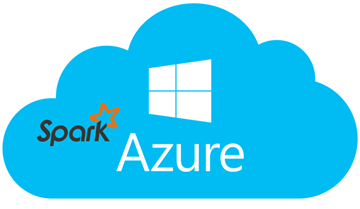
Since its birth in 2009, and the time it was open sourced in 2010, Apache Spark has grown to become one of the largest open source communities in big data with over 400 organizations from 100 companies contributing to it. Spark stands out for its ability to process large volumes of data 100x faster, because data is persisted in-memory. Azure cloud makes Apache Spark incredibly easy and cost effective to deploy with no hardware to buy, no software to configure, with a full notebook experience to author compelling narratives, and integration with partner business intelligence tools. In this blog post, I am going to review of some of the truly game-changing usage scenarios with Apache Spark on Azure that companies can employ in their context.
Scenario #1: Streaming data, IoT and real-time analytics
Apache Spark’s key use case is its ability to process streaming data. With so much data being processed on a daily basis, it has become essential for companies to be able to stream and analyze it all in real time. Spark Streaming has the capability to handle this type of workload exceptionally well. As shown in the image below, a user can create an Azure Event Hub (or an Azure IoT Hub) to ingest rapidly arriving data into the cloud; both Event and IoT Hubs can intake millions of events and sensor updates per second that can then be processed in real-time by Spark.
Businesses can use this scenario today for:
- Streaming ETL: In traditional ETL (extract, transform, load) scenarios, the tools are used for batch processing, and data must be first read in its entirety, converted to a database compatible format, and then written to the target database. With Streaming ETL, data is continually cleaned and aggregated before it is pushed into data stores or for further analysis.
- Data enrichment: Streaming capability can be used to enrich live data by combining it with static or ‘stationary’ data, thus allowing businesses to conduct more complete real-time data analysis. Online advertisers use data enrichment to combine historical customer data with live customer behavior data and deliver more personalized and targeted ads in real-time and in the context of what customers are doing. Since advertising is so time-sensitive, companies have to move fast if they want to capture mindshare. Spark on Azure is one way to help achieve that.
- Trigger event detection: Spark Streaming can allow companies to detect and respond quickly to rare or unusual behaviors (“trigger events”) that could indicate a potentially serious problem within the system. For instance, financial institutions can use triggers to detect fraudulent transactions and stop fraud in its tracks. Hospitals can also use triggers to detect potentially dangerous health changes while monitoring patient vital signs and sending automatic alerts to the right caregivers who can then take immediate and appropriate action.
- Complex session analysis: Using Spark Streaming, businesses can use events relating to live sessions, such as user activity after logging into a website or application, can be grouped together and quickly analyzed. Session information can also be used to continuously update machine learning models. Companies can then use this functionality to gain immediate insights as to how users are engaging on their site and provide more real-time personalized experiences.
Scenario #2: Visual data exploration and interactive analysis
Using Spark SQL running against data stored in Azure, companies can use BI tools such as Power BI, PowerApps, Flow, SAP Lumira, QlikView and Tableau to analyze and visualize their big data. Spark’s interactive analytics capability is fast enough to perform exploratory queries without sampling. By combining Spark with visualization tools, complex data sets can be processed and visualized interactively. These easy-to-use interfaces then allow even non-technical users to visually explore data, create models and share results. Because wider audience can analyze big data without preconceived notions, companies can test new ideas and visualize important findings in their data earlier than ever before. Companies can identify new trends and new relationships that were not apparent before and quickly drill down into them, ask new questions and find ways to innovate in new and smarter ways.
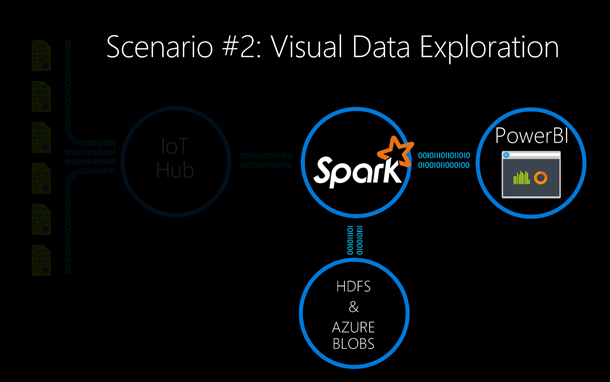
This scenario is even more powerful when interactive data discovery is combined with predictive analytics (more on this later in this blog). Based on relationships and trends identified during discovery, companies can use logistic regression or decision tree techniques to predict the probability of certain events in the future (e.g., customer churn probability). Companies can then take specific, targeted actions to control or avert certain events.
Scenario #3: Spark with NoSQL (HBase and Azure DocumentDB)
This scenario provides scalable and reliable Spark access to NoSQL data stored either in HBase or our blazing fast, planet-scale Azure DocumentDB, through “native” data access APIs. Apache HBase is an open-source NoSQL database that is built on Hadoop and modeled after Google BigTable. DocumentDB is a true schema-free managed NoSQL database service running in Azure designed for modern mobile, web, gaming, and IoT scenarios. DocumentDB ensures 99% of your reads are served under 10 milliseconds and 99% of your writes are served under 15 milliseconds. It also provides schema flexibility, and the ability to easily scale a database up and down on demand.
The Spark with NoSQL scenario enables ad-hoc, interactive queries on big data. NoSQL can be used for capturing data that is collected incrementally from various sources across the globe. This includes social analytics, time series, game or application telemetry, retail catalogs, up-to-date trends and counters, and audit log systems. Spark can then be used for running advanced analytics algorithms at scale on top of the data coming from NoSQL.
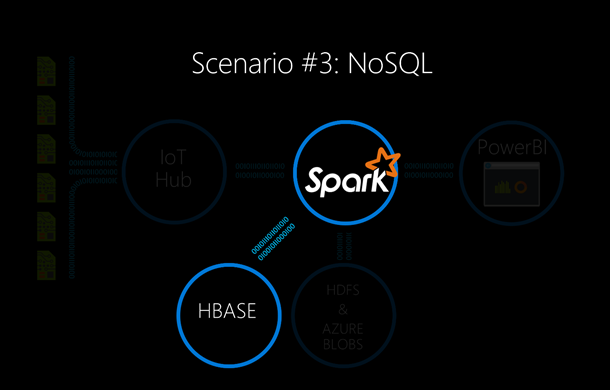
Companies can employ this scenario in online shopping recommendations, spam classifiers for real time communication applications, predictive analytics for personalization, and fraud detection models for mobile applications that need to make instant decisions to accept or reject a payment. I would also include in this category a broad group of applications that are really “next-gen” data warehousing, where large amounts of data needs to be processed inexpensively and then served in an interactive form to many users globally. Finally, internet of things scenarios fit in here as well, with the obvious difference that the data represents the actions of machines instead of people.
Scenario #4: Spark with Data Lake
Spark on Azure can be configured to use Azure Data Lake Store (ADLS) as an additional storage. ADLS is an enterprise-class, hyper-scale repository for big data analytic workloads. Azure Data Lake includes all the capabilities required to make it easy for developers, data scientists, and analysts in an enterprise environment to store data of any size, shape and speed, and do all types of processing and analytics across platforms and languages. Because ADLS is a file system compatible with Hadoop Distributed File System (HDFS), it makes it very easy to combine it with Spark for running computations at scale using pre-existing Spark queries.
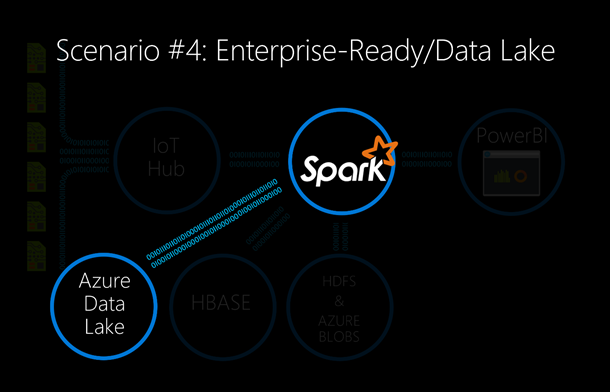
The data lake scenario arose because new types of data needed to be captured and exploited by companies, while still preserving all of the enterprise-level requirements like security, availability, compliance, failover, etc. Spark with data lake scenario enables a truly scalable advanced analytics on healthcare data, financial data, business-sensitive data, geo-location coordinates, clickstream data, server log, social media, machine and sensor data. If companies want an easy way of building data pipelines, have unparalleled performance, insure their data quality, manage access control, perform change data capture (CDC) processing, get enterprise-level security seamlessly and have world-class management and debugging tools, this is the scenario they need to implement.
Scenario #5: Spark with SQL Data Warehouse
While there is still a lot of confusion, Spark and big data analytics is not a replacement for traditional data warehousing. Instead, Spark on Azure can complement and enhance a company’s data warehousing efforts by modernizing the company’s approaches to analytics. A data warehouse can be viewed as an ‘information archive’ that supports business intelligence (BI) users and reporting tools for mission-critical functions of company. My definition of mission-critical is any system that supports revenue generation or cost control. If such a system fails, companies would have to manually perform these tasks to prevent loss of revenue or increased cost. Big data analytics systems like Spark help augment such systems by running more sophisticated computations, smarter analytics and delivering deeper insights using larger and more diverse datasets.
Azure SQL Data Warehouse (SQLDW) is a cloud-based, scale-out database capable of processing massive volumes of data, both relational and non-relational. Built on our massively parallel processing (MPP) architecture, SQLDW combines the power of the SQL Server relational database with Azure cloud scale-out capabilities. You can increase, decrease, pause, or resume a data warehouse in seconds with SQLDW. Furthermore, you save costs by scaling out CPU when you need it and cutting back usage during non-peak times. SQLDW is the manifestation of elastic future of data warehousing in the cloud.
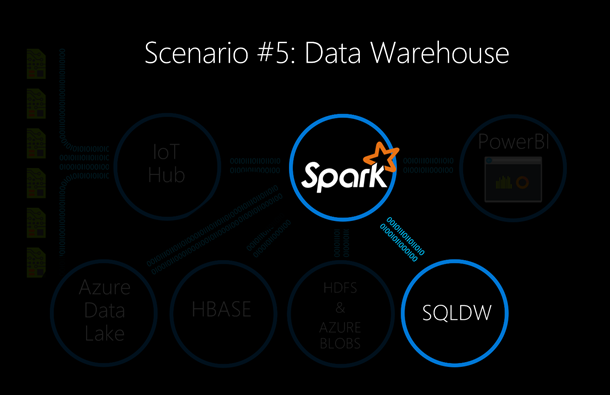
Some of the use cases of Spark with SQLDW scenario may include: using data warehouse to get a better understanding of its customers across product groups, then using Spark for predictive analytics on top of that data. Running advanced analytics using Spark on top of the enterprise data warehouse containing sales, marketing, store management, point of sale, customer loyalty, and supply chain data, then run advanced analytics using Spark to drive more informed business decisions at the corporate, regional, and store levels. Using Spark with the data warehousing data, companies can literally do anything from risk modeling, to parallel processing of large graphs, to advanced analytics, text processing – all on top of their elastic data warehouse.
Scenario #6: Machine Learning using R Server, MLlib
Another and probably one of the most prominent Spark use cases in Azure is machine learning. By storing datasets in-memory during a job, Spark has great performance for iterative queries common in machine learning workloads. Common machine learning tasks that can be run with Spark in Azure include (but are not limited to) classification, regression, clustering, topic modeling, singular value decomposition (SVD) and principal component analysis (PCA) and hypothesis testing and calculating sample statistics.
Typically, if you want to train a statistical model on very large amounts of data, you need three things:
- Storage platform capable of holding all of the training data
- Computational platform capable of efficiently performing the heavy-duty mathematical computations required
- Statistical computing language with algorithms that can take advantage of the storage and computation power
Microsoft R Server, running on HDInsight with Apache Spark provides all three things above. Microsoft R Server runs within HDInsight Hadoop nodes running on Microsoft Azure. Better yet, the big-data-capable algorithms of ScaleR takes advantage of the in-memory architecture of Spark, dramatically reducing the time needed to train models on large data. With multi-threaded math libraries and transparent parallelization in R Server, customers can handle up to 1000x more data and up to 50x faster speeds than open source R. And if your data grows or you just need more power, you can dynamically add nodes to the Spark cluster using the Azure portal. Spark in Azure also includes MLlib for a variety of scalable machine learning algorithms, or you can use your own libraries. Some of the common applications of machine learning scenario with Spark on Azure are listed in a table below.
| Vertical | Sales and Marketing | Finance and Risk | Customer and Channel | Operations and Workforce |
| Retail |
Demand forecasting Loyalty programs Cross-sell and upsell Customer acquisition |
Fraud detection Pricing strategy |
Personalization Lifetime customer value Product segmentation |
Store location demographics Supply chain management Inventory management |
| Financial Services |
Customer churn Loyalty programs Cross-sell and upsell Customer acquisition |
Fraud detection Risk and compliance Loan defaults |
Personalization Lifetime customer value |
Call center optimization Pay for performance |
| Healthcare |
Marketing mix optimization Patient acquisition |
Fraud detection Bill collection |
Population health Patient demographics |
Operational efficiency Pay for performance |
| Manufacturing |
Demand forecasting Marketing mix optimization |
Pricing strategy Perf risk management |
Supply chain optimization Personalization |
Remote monitoring Predictive maintenance Asset management |
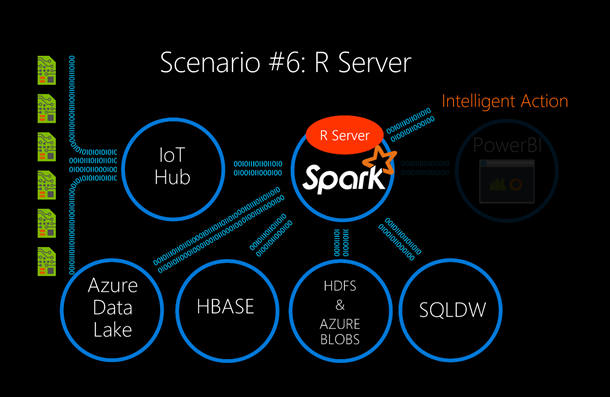
Examples with just a few lines of code that you can try out right now:
- Predict food inspection results using Machine Learning + Spark
- Predict building temperature using Machine Learning + Spark
Scenario #7: Putting it all together in a notebook experience
For data scientists, we provide out-of-the-box integration with Jupyter (iPython), the most popular open source notebook in the world. Unlike other managed Spark offerings that might require you to install your own notebooks, we worked with the Jupyter OSS community to enhance the kernel to allow Spark execution through a REST endpoint.
We co-led “Project Livy” with Cloudera and other organizations to create an open source Apache licensed REST web service that makes Spark a more robust back-end for running interactive notebooks. As a result, Jupyter notebooks are now accessible within HDInsight out-of-the-box. In this scenario, we can use all of the services in Azure mentioned above with Spark with a full notebook experience to author compelling narratives and create data science collaborative spaces. Jupyter is a multi-lingual REPL on steroids. Jupyter notebook provides a collection of tools for scientific computing using powerful interactive shells that combine code execution with the creation of a live computational document. These notebook files can contain arbitrary text, mathematical formulas, input code, results, graphics, videos and any other kind of media that a modern web browser is capable of displaying. So, whether you’re absolutely new to R or Python or SQL or do some serious parallel/technical computing, the Jupyter Notebook in Azure is a great choice.
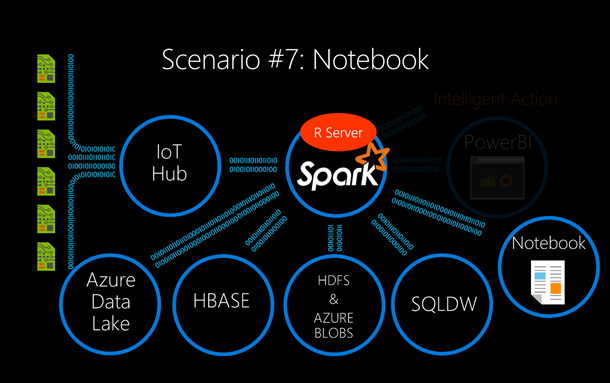
You can also use Zeppelin notebooks on Spark clusters in Azure to run Spark jobs. Zeppelin notebook for HDInsight Spark cluster is an offering just to showcase how to use Zeppelin in an Azure HDInsight Spark environment. If you want to use notebooks to work with HDInsight Spark, I recommend that you use Jupyter notebooks. To make development on Spark easier, we support IntelliJ Spark Tooling which introduces native authoring support for Scala and Java, local testing, remote debugging, and the ability to submit Spark applications to the Azure cloud.
Scenario #8: Using Excel with Spark
As a final example, I wanted to describe the ability to connect Excel to Spark cluster running in Azure using the Microsoft Open Database Connectivity (ODBC) Spark Driver. Download it here.
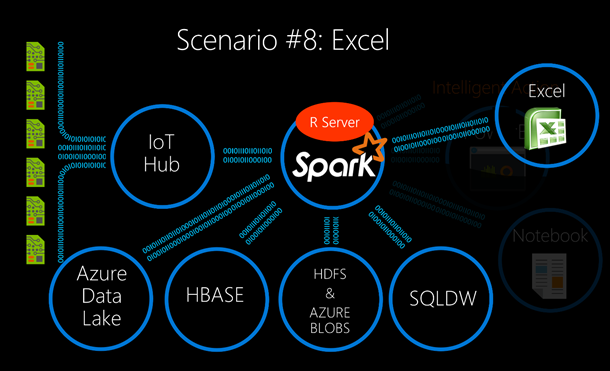
Excel is one of the most popular clients for data analytics on Microsoft platforms. In Excel, our primary BI tools such as PowerPivot, data-modeling tools, Power View, and other data-visualization tools are built right into the software, no additional downloads required. This enables users of all levels to do self-service BI using the familiar interface of Excel. Through a Spark Add-in for Excel users can easily analyze massive amounts of structured or unstructured data with a very familiar tool.
Conclusion
Above, I’ve described some of the amazing, game-changing scenarios for real-time big data processing with Spark on Azure. Any company across the globe, from a huge enterprise to a small startup can take their business to the next level with these scenarios and solutions. The question is, what are you waiting for?



